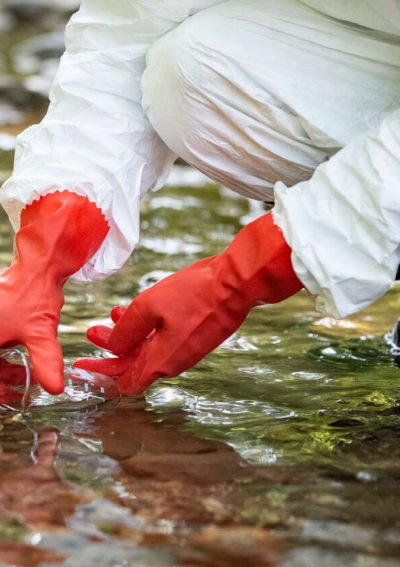Neurobehavioral Effects of Exposure to Contaminated Camp Lejeune Water
Exposure to Camp Lejeune water contaminated with toxic chemicals that damage how the nervous system works has caused emotional, behavioral and learning problems. These neurobehavioral effects include memory problems, insomnia, headaches, poor concentration, dementia, anxiety and Parkinson’s disease.

What Are Neurobehavioral Effects?
Neurobehavioral effects are conditions that have to do with the way the brain communicates with the nervous system, according to the National Institutes of Health. These effects can manifest as behavioral, emotional, physical or learning problems.
Brain injury, illness or exposure to toxins — such as the chemicals in contaminated water from Camp Lejeune — can cause neurobehavioral effects. The symptoms of neurobehavioral effects depend on how much damage the brain has sustained.
Symptoms of Neurobehavioral Effects
People with neurobehavioral effects typically report experiencing changes in mood, personality, attention and memory. Other neurological effects manifest as motor dysfunction, including coordination or balance problems.
Certain chemicals can seriously affect the part of the brain that controls motor function and cause tremors, ticks and even Parkinson’s disease.
- Anxiety
- Changes in mood or personality
- Confusion
- Depression
- Dizziness
- Fatigue
- Headaches
- Insomnia
- Involuntary muscle movements (dystonia or dyskinesia)
- Irritability
- Learning disorders
- Memory problems
- Motor problems (balance, coordination, etc.)
- Parkinson’s disease
- Poor concentration
- Tension
- Tremors
Neurobehavioral effects from exposure to toxic chemicals may last anywhere from a few minutes to several years. Mild effects from low levels of chemicals and short exposures may be reversible, but severe damage from long-term chronic exposure to high levels of chemicals may be permanent.
Link Between Neurobehavioral Effects and Camp Lejeune Water
The Department of Veterans Affairs and Centers for Disease Control and Prevention have linked toxic chemicals found in contaminated Camp Lejeune water to neurobehavioral effects. In fact, the VA provides health and compensation benefits for veterans who suffered neurological effects after being stationed at Camp Lejeune from the 1950s to early 1980s.
The four main toxic chemicals in the Camp Lejeune water supply were trichloroethylene (TCE), perchloroethylene (PCE), benzene and vinyl chloride. According to one study published in Environmental Research, “long-term exposure to low concentrations of TCE is associated with neurobehavioral deficits.” On average, Marine or Navy personnel were stationed at Camp Lejeune for about 18 months.
The maximum safe contaminant levels for TCE in drinking water is 5 parts per billion (parts per billion). Levels of TCE in contaminated Camp Lejeune water plants was an average of 366 ppb. Levels of perchloroethylene (PCE), benzene and vinyl chloride were also far above safe limits.
Marines at Camp Lejeune could have consumed as much as one to two quarts of water an hour and showered twice per day during training, according to a Camp Lejeune report from the Agency for Toxic Substances and Disease Registry. Contaminated water was also used in hospitals, schools, homes and other areas around the base, exposing civilians and family.
Neurobehavioral Deficits and Testing Options
There are thousands of tests that researchers and health care providers use to determine if a person has a neurobehavioral deficit because of toxins.
Three of these neurobehavioral testing options are:
- WHO Neurobehavioral Core Test Battery (WHO-NCTB)
- Neurobehavioral Evaluation System (NES)
- Adult Environmental Neurobehavioral Test Battery (AENTB)
Experts created these testing systems beginning in the 1970s to check for signs of damage from toxin exposure. These tests involve having participants perform tasks that test motor function, memory, reaction time and coordination. Today, many variations of these tests exist.
VA Compensation for Camp Lejeune Neurobehavioral Effects
Neurobehavioral effects acquired from exposure to contaminated Camp Lejeune water are eligible for VA health care benefits. If you have qualifying service at Camp Lejeune or are a family member who lived or worked on base, you may be eligible.

Specifically, the VA has said that it may reimburse out-of-pocket health care costs related to neurobehavioral effects. You may qualify for disability if you have Parkinson’s disease, which is a type of neurological disorder.
To qualify, you have to have been stationed at Camp Lejeune or MCAS New River for at least 30 days. The service period can be anytime from August 1953 through December 1987.
- Military service records showing service at Camp Lejeune
- Family members must show proof of relationship to a veteran who served at Camp Lejeune (marriage license, adoptions papers, birth certificate, etc.)
- Family members must show they lived at Camp Lejeune (tax forms, utility bills, etc.)
- Medical records that show diagnosis of neurobehavioral effects that may be related to chemical exposure on base
- Evidence you paid for medical care for neurobehavioral effects for reimbursement
To make the process easier, family members may ask their physicians to fill out a Camp Lejeune Family Member Program Treating Physician Report (VA Form 10-10068b). It’s not required but may help the VA make a decision about your eligibility.
What Does It Mean to Have a Presumptive Condition for Toxic Exposure?
Having a presumptive condition for toxic exposure means that the VA automatically assumes a veteran’s health conditions are linked to their service. This makes it easier to get VA benefits, and it may help veterans who filed a Camp Lejeune lawsuit for compensation.
Normally, to get VA disability benefits, veterans must connect their health problems to their service. But in the case of Camp Lejeune and other toxic exposures, the VA already presumes several health conditions are linked to Camp Lejeune water contamination exposure. If a Camp Lejeune veteran has a health condition on the presumptive conditions list provided by the VA, they don’t need to prove a service connection for VA benefits.
What to Do if You Have Neurobehavioral Effects from Camp Lejeune Water
If you have symptoms of neurobehavioral effects from exposure to contaminated Camp Lejeune water, talk to your doctor about your treatment options. Make sure to file a claim for VA benefits. You earned these benefits, and you shouldn’t have to pay out-of-pocket expenses for care.
VA compensation for neurological effects from Camp Lejeune water may be limited to out-of-pocket expenses. But veterans and their families may have another avenue to get compensation. A new law called the Camp Lejeune Justice Act of 2022 gives people affected by contaminated water at the base the right to file a Camp Lejeune lawsuit against the U.S. government for illnesses linked to water contamination.
After the bill cleared the Senate in August 2022, the President signed it into law under the Sergeant First Class Heath Robinson Honoring Our PACT Act of 2022. The White House calls it the “the largest single bill in American history to address our service members’ exposure to burn pits and other toxic substances.”
If you are interested in filing a lawsuit, make sure you speak to a lawyer right away. There are time limits for filing your case, and you should preserve your right to sue.
14 Cited Research Articles
Consumernotice.org adheres to the highest ethical standards for content production and references only credible sources of information, including government reports, interviews with experts, highly regarded nonprofit organizations, peer-reviewed journals, court records and academic organizations. You can learn more about our dedication to relevance, accuracy and transparency by reading our editorial policy.
- Department of Veterans Affairs. (2023, March 28). Exposure to burn pits and other specific environmental hazards. Retrieved from https://www.va.gov/disability/eligibility/hazardous-materials-exposure/specific-environmental-hazards/
- White House. (2022, August 10). FACT SHEET: President Biden Signs the PACT Act and Delivers on His Promise to America’s Veterans. Retrieved from https://www.whitehouse.gov/briefing-room/statements-releases/2022/08/10/fact-sheet-president-biden-signs-the-pact-act-and-delivers-on-his-promise-to-americas-veterans/
- The White House. (2022, June 16). Statement by President Joe Biden on Bipartisan Senate Passage of the PACT Act. Retrieved from https://www.whitehouse.gov/briefing-room/statements-releases/2022/06/16/statement-by-president-joe-biden-on-bipartisan-senate-passage-of-the-pact-act/
- Department of Veterans Affairs (2022, March 7). Camp Lejeune water contamination health issues. Retrieved from https://www.va.gov/disability/eligibility/hazardous-materials-exposure/camp-lejeune-water-contamination/
- Agency for Toxic Substances and Disease Registry. (2017, January 16). ATSDR Assessment of the Evidence for the Drinking Water Contaminants at Camp Lejeune and Specific Cancers and Other Diseases. Retrieved from https://www.atsdr.cdc.gov/sites/lejeune/docs/ATSDR_summary_of_the_evidence_for_causality_TCE_PCE_508.pdf
- Committee on the Review of Clinical Guidance for the Care of Health Conditions Identified by the Camp Lejeune Legislation. (2015, March 26). Review of VA Clinical Guidance for the Health Conditions Identified by the Camp Lejeune Legislation. Retrieved from https://www.ncbi.nlm.nih.gov/books/NBK284982/
- Agency for Toxic Substances and Disease Registry. (2014, January 16). Camp Lejeune, North Carolina. Retrieved from https://www.atsdr.cdc.gov/sites/lejeune/chem_descriptions.html
- Agency for Toxic Substances and Disease Registry. (2014, January 16). Camp Lejeune, North Carolina. Retrieved from https://www.atsdr.cdc.gov/sites/lejeune/background.html
- Agency for Toxic Substances and Disease Registry. (2014, January 16). Health effects linked with trichloroethylene (TCE), tetrachloroethylene, benzene, and vinyl chloride exposure. Retrieved from https://www.atsdr.cdc.gov/sites/lejeune/tce_pce.html
- National Research Council (US) Committee on Contaminated Drinking Water at Camp Lejeune. (2009). Contaminated Water Supplies at Camp Lejeune: Assessing Potential Health Effects. Retrieved from https://www.ncbi.nlm.nih.gov/books/NBK215286/
- Reif, J.S. et al. (2003, November). Neurobehavioral effects of exposure to trichloroethylene through a municipal water supply. Retrieved from https://pubmed.ncbi.nlm.nih.gov/14615234/
- Ratner, M.H. et al. (2002). Neurobehavioral Toxicology. Retrieved from https://www.bumc.bu.edu/busm-pm/files/2015/08/Neurobehavioral-Toxicology.pdf
- Department of Veterans Affairs (n.d.). Camp Lejeune: Past Water Contamination. Retrieved from https://www.publichealth.va.gov/exposures/camp-lejeune/
- Anger, K.W. (2003). Neurobehavioural Tests And Systems To Assess Neurotoxic Exposures In The Workplace And Community. Retrieved from https://oem.bmj.com/content/60/7/531
Calling this number connects you with a Consumer Notice, LLC representative. We will direct you to one of our trusted legal partners for a free case review.
Consumer Notice, LLC's trusted legal partners support the organization's mission to keep people safe from dangerous drugs and medical devices. For more information, visit our partners page.
844-526-0648
